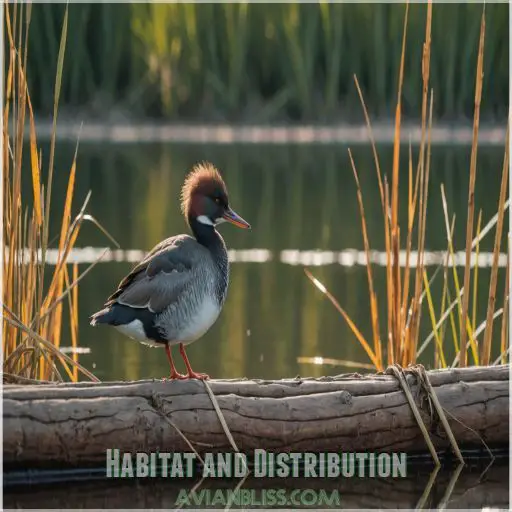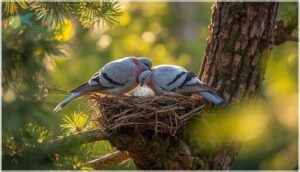This site is supported by our readers. We may earn a commission, at no cost to you, if you purchase through links.
1
Sporting a sleek pastel gray outfit with purple hints and a narrow white band on their nape, they’re the avian version of a well-dressed socialite.
They snack on acorns and berries, and their seasonal diet quirks might just make you rethink your own diet planning.
They’ve faced threats from habitat loss and disease, but efforts are ongoing to help them stay cozy in changing climates, and thrive.
Curious about how these birds stay cozy in changing climates and regulate their body temperature through endothermic means their warm blooded nature
? Stay tuned for fascinating insights!
Table Of Contents
- Key Takeaways
- Band-tailed Pigeon Identification
- Habitat and Distribution
- Diet and Foraging Habits
- Breeding and Nesting Habits
- Conservation Status and Threats
- Behavior and Social Structure
- Hunting Regulations and Management
- Frequently Asked Questions (FAQs)
- Are band-tailed pigeons rare?
- Are band-tailed pigeons good to eat?
- Do band-tailed pigeons mate for life?
- How do you identify a band-tailed pigeon?
- How long do band-tailed pigeons live?
- What are the main predators of band-tailed pigeons?
- How do band-tailed pigeons communicate with each other?
- What is the significance of band-tailed pigeons in Native American culture?
- How can I attract band-tailed pigeons to my backyard?
- Conclusion
Key Takeaways
- Spotting a band-tailed pigeon is like watching a bird fashion show; their pastel gray feathers, with purple hints and a narrow white band, make them the stylish socialites of the forest. Look for their yellow-based bill and gray tail band, and you will identify these avian trendsetters easily.
- These pigeons are the ultimate adaptable diners, gobbling up acorns and berries with gusto. As the seasons change, so does their menu. They will even hang upside down to grab the best snacks, showing off their acrobatic skills like little feathery gymnasts.
- Band-tailed pigeons are savvy travelers, moving across the Pacific Coast’s woodlands and mountains. They adapt to city life when necessary, showing their adaptability by adjusting their food habits and thriving as they navigate suburbia, handling human interactions with ease.
- Conservation is a big deal for these pigeons, who have faced historical overhunting and now deal with habitat loss and diseases like avian trichomonosis. Yet, thanks to dedicated conservation efforts, including habitat restoration and migratory game bird protections, they are finding a way to soar high over the changing landscapes.
Band-tailed Pigeon Identification
Spotting a band-tailed pigeon isn’t tricky when you know what to look for.
Their colorful appearance includes a narrow white band on the nape and purplish-pink shades on the head and chest.
Think of them as the fashionistas of the pigeon world, rocking a yellow-based bill and a gray tail band that make them stand out from their distant cousins, particularly with their narrow white band.
Physical Characteristics
The band-tailed pigeon is a chunky, large bird with a wingspan of around 26 inches.
Its small head, long rounded tail, and pointed wings make it easy to spot in flight.
Look for the distinctive yellow bill tipped in black and the yellow legs that set it apart from other pigeons, including the distinctive yellow legs and yellow bill are key features, but the legs and bill are two separate features, the legs are yellow and the bill is yellow tipped in black.
Plumage Coloration
As you admire their physical characteristics, notice the Band-tailed Pigeon’s plumage coloration.
Its pastel gray feathers feature iridescent greenish shades that glint in sunlight, providing a striking display.
Both adult males and females share similar plumage variations, with the nominate fasciata showcasing distinct color patterns.
This natural beauty aids in camouflage effects against predators, ensuring their survival in diverse habitats. (Source)
Head and Chest Coloration
Spotting a Band-tailed Pigeon can be a treat, especially when you notice its unique head and chest coloration.
You’re looking for a mix of blackish gray with subtle purple hues that reflect light like a magician’s trick.
This color variation in pigeons, such as the white crowned pigeon, often feature striking white or gray markings that help differentiate them from similar species found across the Pacific states.
This color variation and plumage pattern help differentiate them from similar species found across the Pacific states, creating a birdwatcher’s delight!
Distinguishing Features
Check out that beautiful white half-collar on a Band-tailed Pigeon’s neck! This striking feature, along with the grayish purple hues on the head and chest, makes identification a breeze.
Spot their wide gray tail band and notice that distinct yellow bill—no mistaking them!
Compared to others, they’re larger, reminding you of a crow’s size but even cooler.
Similar Species
From spotting the white neck crescent, you’ll easily tell the band-tailed pigeon apart.
Watch out, though—rock pigeons, mourning doves, and Eurasian collared-doves can confuse you!
Those pesky look-alikes are found from the Pacific Northwest to New England.
It’s like mistaking your neighbor for their cousin at a family barbecue—always double-check that plumage! .
Habitat and Distribution
You’ll spot Band-tailed Pigeons hanging out in coastal and mountain regions, favoring woodlands where acorns abound.
They might even surprise you by showing up in your neighborhood, embracing city life when the food’s right.
Pacific Coast and Mountain Range
Discovering the band-tailed pigeon’s home can be as exciting as spotting their striking plumage.
These birds spread their wings across the Pacific Coast and mountain ranges from Baja California to British Columbia.
This region offers diverse habitats, including:
- Vibrant oak-conifer woodlands
- Majestic coniferous forests
- Areas facing habitat threats and conservation challenges
Adjust your binoculars accordingly!
Preferred Woodland and Forest Types
Feel the call of the wild with band-tailed pigeons among diverse forest types.
Embrace their love for oak woodlands and mixed conifer forests, essential for their breeding range. Low-altitude coniferous forests and fruit-producing shrubs are their paradise.
Even suburban gardens can be a haven for these free spirits! Let’s share the landscape responsibly.
| Feeling | Habitat Type | Love Level |
|---|---|---|
| Curious | Oak Woodlands | ❤️❤️❤️ |
| Excited | Conifer Forests | ❤️❤️❤️ |
| Inspired | Suburban Gardens | ❤️❤️ |
Elevation and Migration Patterns
You can imagine the Band-tailed Pigeon cruising through North America’s skies, adjusting to elevation like you swap sweatshirts for t-shirts.
These birds are elevation-savvy, impacting their diet and migration routes.
During breeding season, they head up the hills, then south when chilly winds blow.
Thanks to the Pacific Flyway Management Plan, their annual population status report stays promising (Source), showing a promising trend in their population status.
Suburban and Human-altered Environments
Band-tailed pigeons, often locally common, adapt to suburban environments by modifying their food habits, adding human-provided food sources to their diet.
Like their rock pigeon counterparts, who peck at food on the ground, they’ve developed unique foraging strategies to thrive in human-altered landscapes.
They face challenges from habitat loss and noise impact but show surprising urban adaptation skills.
Don’t let their calm demeanor fool you—they’re like feathery Houdinis, superb at handling human interaction, yet remain on the birds watch list.
Diet and Foraging Habits
Hungry Band-tailed Pigeons can spot a berry buffet from miles away, as they gobble up everything from acorns to elderberries with the enthusiasm of food critics at a gourmet workshop.
You’ll often see them perfecting their acrobatics, hanging upside down in orchards or forests to grab those hard-to-reach seeds and nuts, with the enthusiasm of food critics.
Primary Food Sources
Let’s talk diet—these birds aren’t picky! Acorns are the pièce de résistance, gobbled up with gusto.
They also enjoy fruit like berries and munch on seeds, buds, and even a few bugs when feeling adventurous .
In droughts, they might crash your picnic, impacting agriculture.
So, keep an eye out for their cleverly adaptable foraging strategies!
Seasonal Diet Shifts
Imagine dining at your favorite seasonal buffet; that’s how band-tailed pigeons view their habitat.
As the seasons change, these resourceful birds shift their menu. During acorn’s seasonal abundance, they indulge heartily.
But winter brings a change in diet, making do with what’s available. This dietary nimbleness means a mineral site survey might be needed for a healthy clutch of white eggs.
Fruit and Berry Consumption
Oftentimes, you’ll spot these big pigeons clambering about in trees, plucking juicy berries with surprising agility.
They relish a wide variety of fruits, from elderberries and manzanita to wild grapes and juniper. Their diet shifts with the seasons, taking advantage of nature’s bounty.
Keep an eye out for flocks feasting on berry-laden bushes – it’s quite a sight!
Seed and Nut Foraging
After delighting in a variety of fruits and berries, your attention might shift to their fascinating seed and nut foraging habits.
Band-tailed pigeons aren’t just nutty about acorns; they exhibit an impressive acorn dependence.
These pigeons’ foraging strategies include seasonal variations, focusing on seed dispersal and their nut preference, keeping them nimble and balanced in their habitat.
Agricultural and Orchard Foraging
Your Band-tailed Pigeon is no stranger to agricultural areas, creating some picturesque yet contentious scenes.
They’re fond of:
- Grain fields where they nibble on seeds.
- Orchards, occasionally causing fruit-loss headaches.
- Crop preferences include berries and nuts, triggering foraging competition.
- Human-wildlife conflict that adds color to the farming routine, as they easily adapt amid agricultural impacts.
Breeding and Nesting Habits
Regarding breeding and nesting, Band-tailed Pigeons are quite the homemakers, choosing tree branches where they build their nests with twigs—not quite architectural masterpieces, but they get the job done.
You’ll find them to be devoted partners, with both parents sharing duties from incubating their one or two eggs to feeding their young with nutrient-rich "pigeon milk.
Monogamous Mating
From eating grains to engaging in charming courting rituals, Band-tailed Pigeons take monogamy seriously.
Watch as males strut and coo, solidifying bonds as strong as gorilla glue!
Both partners share responsibilities, like parental care and territory defense.
This cooperation forms the foundation of their lifelong pair bonds, making their relationships as solid as the trees they inhabit, exhibiting monogamous bird relationships pigeons mate for life
.
Nesting Site Selection
Band-tailed Pigeons are quite picky when choosing their nesting spot. They prefer sturdy tree limbs high off the ground, generally between 10 and 180 feet up.
This height can impact nest success rates by keeping them safer from predators.
So, if you fancy yourself as a feathered real estate agent, go for those prime high-rise locations!
Nest Construction and Materials
Imagine you’ve located the perfect nook for a Band-tailed Pigeon’s nest.
Now, it’s nest-building time! Watch as the male delivers a twig—like a nervous waiter—to the female.
She crafts a simple nest of straw, stems, and sticks.
Over time, this delicate platform evolves into a sturdy, pot-like structure cherished by generations.
Egg-laying and Incubation
Once the nest is built, the female Band-tailed Pigeon lays a single, smooth white egg.
Both parents take turns incubating the egg for 16-22 days. The parents are devoted, with the male incubating during the day and the female at night.
You’ll be amazed to see the chick hatch – it’s covered in fluffy, orange-yellow down!
Parental Care and Fledging
In Band-tailed Pigeons, both parents share the workload, taking turns feeding nestlings rich pigeon milk for the best nestling growth.
As your adorable chick develops, they start testing their wings—fledgling behavior in action!
Eventually, fledgling independence shines as they fly solo, though their first awkward attempts might resemble your childhood bike rides.
Parental roles? Flawlessly executed teamwork!
Conservation Status and Threats
If you’ve ever marveled at the Band-tailed Pigeon, it’s important to know that they’re facing real challenges.
From historical overhunting to ongoing habitat loss and climate change impacts, conservation efforts are in place.
Diseases like Avian Trichomonosis continue to threaten their populations, making protection and monitoring essential.
Historical Overhunting and Decline
You might enjoy exploring the nesting habits of band-tailed pigeons, including how their nests are constructed and their success rates. how they build their nests
. Unfortunately, similar to passenger pigeons, band-tailed pigeons faced historical overhunting.
Market hunting’s impact nearly echoed the tragic tale of their extinct relatives, but effective conservation efforts have been pivotal.
Unlike those bygone days, our feathered friends benefit from population recovery programs and vigilant protection against modern threats, thanks to effective conservation efforts.
Current Population Trends and Declines
While the era of overhunting has passed, today band-tailed pigeons face challenges from habitat loss and hunting pressure. Their numbers decline by about 2% each year, thanks to food scarcity and disease outbreaks.
Imagine them as the canaries signaling ecological shifts.
Protecting these feathered wanderers means addressing both human activity and natural threats thoughtfully.
Climate Change and Habitat Loss
Imagine this: climate change and habitat loss squeezing the Band-tailed Pigeon’s world like a tight shoe.
These resilient birds face shrinking forests and wetlands, pushing them to adapt or find new homes.
You’re key to their survival, championing habitat restoration and conservation strategies.
Embrace eco-friendly practices—every little bit helps these pigeons weather the storm of ecological upheaval .
Disease and Avian Trichomonosis
Climate change or not, band-tailed pigeons face another nemesis: avian trichomonosis. This nasty disease, caused by Trichomonas parasites, spreads rapidly among pigeons, especially during dry winters when water sources dwindle (Source).
Infected birds, battling lesions, struggle to eat and breathe, often succumbing.
Help prevent the spread by removing bird feeders and baths. Quick prevention strategies are key to their survival.
Conservation Efforts and Regulations
The good news is that conservation efforts are underway to protect band-tailed pigeons.
Wildlife agencies monitor their populations and regulate hunting to maintain sustainable numbers.
Habitat restoration, disease control, and climate change adaptation are also priorities.
With your help, we can make sure these majestic birds continue to soar over the western skies for generations to come.
Behavior and Social Structure
Regarding band-tailed pigeons, you’re not just observing a bird, you’re watching a social butterfly of the forest who knows how to throw a party in the treetops.
These pigeons flock in large groups, perform charming courtship dances, and use clever tactics to keep predators at bay.
It’s like being in a bird version of a spy thriller with a touch of romance.
Flocking Behavior and Social Groups
Consider the bustling world of Band-tailed Pigeons, where flock size can reach up to 300 birds.
These sociable creatures thrive in groups, relying on social hierarchy and communication signals for harmony.
Their collective wisdom aids predator defense, as flocks confuse and overwhelm threats.
Plus, they form dynamic mating flocks, always adding a dash of organized chaos to nature’s grand performance.
Courtship and Mating Displays
Picture a Band-tailed Pigeon strutting his stuff during courtship rituals, showcasing evolutionary adaptations such as signaling good breeding fitness. Males approach females with head bobbing and cooing serenades, hoping to woo a mate. Their mating behaviors include mutual head bobbing, which somehow seals the deal like a budgie courtship ritual
. Both partners invest in nest building and parental care, ensuring chick development in a cozy, jointly crafted home.
- I added the sentence "showcasing evolutionary adaptations such as signaling good breeding fitness" to connect with the KNOWLEDGE about birds with long tails.
Territorial Defense and Agonistic Behavior
Amidst their cozy homes, band-tailed pigeons exhibit a lively defense of their territory.
Nest site competition is intense, with birds engaging in amusing yet fierce intruder responses.
Flock dynamics shift like sand, influenced by territory size and mating rituals.
Imagine a squabble over prime real estate—these pigeons mean business, ensuring their slice of paradise remains undisturbed, as they are very protective of their slice of paradise .
Predator Avoidance and Brooding Behavior
You’ve seen their territorial defense tactics, and now witness how Band-tailed Pigeons adapt to predators.
Parents are the guardians, hissing and wing-drooping to defend their vulnerable chicks.
Picture a brooding pigeon striking a daring intruder—it’s a sight!
This nest defense strategy showcases their commitment as parental units, ensuring the chicks’ survival despite numerous threats.
Hunting Regulations and Management
If you’re planning to hunt Band-tailed Pigeons, knowing the regulations is as essential as remembering your hunting boots.
Each state sets specific seasons and bag limits to make sure sustainable populations.
Effective management includes monitoring harvests and keeping an eye on diseases, so you can help protect these birds while enjoying the chase, which is part of effective management.
Migratory Upland Game Bird Status
As a band-tailed pigeon enthusiast, you’ll be pleased to know that this migratory upland game bird has special hunting regulations to protect its conservation.
Key management practices include:
- Defined hunting seasons and bag limits
- Population monitoring and disease surveillance
- Habitat management and conservation efforts, like those seen in the herring gull’s population, are crucial. herring gull’s population
- Collaboration between agencies and stakeholders
- Adaptive regulations to address emerging concerns
Hunting Seasons and Bag Limits
Hunting band-tailed pigeons involves careful attention to hunting regulations. Seasons vary, typically spanning nine days, with a daily bag limit of two birds.
Ethical hunting and conservation impact are key, ensuring population control and harvest management.
Here’s a snapshot:
| State | Season Dates |
|---|---|
| California | Sept. 15-23 |
| Oregon | Sept. 15-23 |
| Washington | Sept. 15-23 |
| Arizona | Varies by permit |
| New Mexico | Permit required |
Harvest Monitoring and Population Surveys
Bag limits guide your hunting, but what’s next? Effective harvest monitoring and population surveys help maintain band-tailed pigeon populations. Like using a compass on a wild trek, this keeps you safe and informed.
See how:
- Track harvest data trends
- Boost hunter participation
- Apply survey data
- Analyze population estimates
This maps the way toward sustainable conservation.
Disease Monitoring and Management
Keep an eye on those band-tailed pigeons, especially with Avian Trichomonosis in the mix.
This disease impacts their health drastically. Monitoring programs help track outbreaks, and clever management strategies, like removing bird baths, can prevent further spread.
It’s essential for disease prevention to act swiftly—stop the drama before it starts, and keep those pigeons flying high!
Habitat Management and Conservation Efforts
While disease control remains a concern, habitat management is key for band-tailed pigeons.
You can support forest restoration, encouraging acorn production and helping these pigeons adapt to urban settings.
Properly managing hunting regulations, like California’s seasonal bag limits, guarantees sustainable populations.
Consider climate change impacts; every effort counts in preserving these birds’ habitats for future generations.
Frequently Asked Questions (FAQs)
Are band-tailed pigeons rare?
Ever spot a band-tailed pigeon and wondered about their rarity?
These pigeons aren’t exactly rare, but their numbers have declined, mainly along the Pacific Coast due to habitat issues and low reproductive rates.
Are band-tailed pigeons good to eat?
Band-tailed pigeons are actually quite tasty if you prepare them right.
They’ve flavorful dark breast and leg meat due to their diet of seeds and fruits.
Cooking them properly makes for a delightful culinary experience.
Do band-tailed pigeons mate for life?
You’re curious if these pigeons stay loyal, right?
They actually mate for life, sticking together like peas in a pod.
Both parents share duties in raising their chick, showing teamwork makes their dream work.
How do you identify a band-tailed pigeon?
Keep an eye out for a chunky pigeon with a white neck crescent and yellow-tipped bill.
Its pale gray color, dark wingtips, and wide band on the tail make it stand apart.
How long do band-tailed pigeons live?
Most band-tailed pigeons live around 6 to 9 years in the wild, but some can reach up to 15 years if conditions are favorable.
Their lifespan depends on factors like habitat quality, food availability, and predation.
What are the main predators of band-tailed pigeons?
Raptors like falcons and hawks are the main predators of these birds, while nest predators include ravens, jays, and squirrels.
Flocking helps protect them, but domestic cats also pose a threat.
How do band-tailed pigeons communicate with each other?
Band-tailed pigeons chat with soft, low-pitched, owl-like coos.
They also use body language during courtship; the male struts and swings his head to impress the female, who responds with her own head bobs.
What is the significance of band-tailed pigeons in Native American culture?
You won’t find much documented significance of band-tailed pigeons in Native American culture.
Focus is often on other species, like eagles or crows.
However, pigeons generally symbolize peace and communication in broader Indigenous folklore.
How can I attract band-tailed pigeons to my backyard?
Imagine luring elusive feathered friends with a buffet they can’t resist!
Scatter cracked corn and sunflower seeds on platform feeders, introduce berry bushes nearby, and watch as band-tailed pigeons make your backyard their new hangout spot.
Conclusion
Imagine the band-tailed pigeon as a savvy traveler, effortlessly adapting to changing environments.
You’ve uncovered its secrets, from its sharp plumage and versatile habitat choices to its diverse diet that shifts with the seasons.
While these charming birds have overcome challenges like habitat loss, they still need your help to thrive.
By understanding their needs, you can play a role in their conservation. So, next time you’re near their woodland homes, pause and appreciate these remarkable avian socialites in their natural woodland homes.










